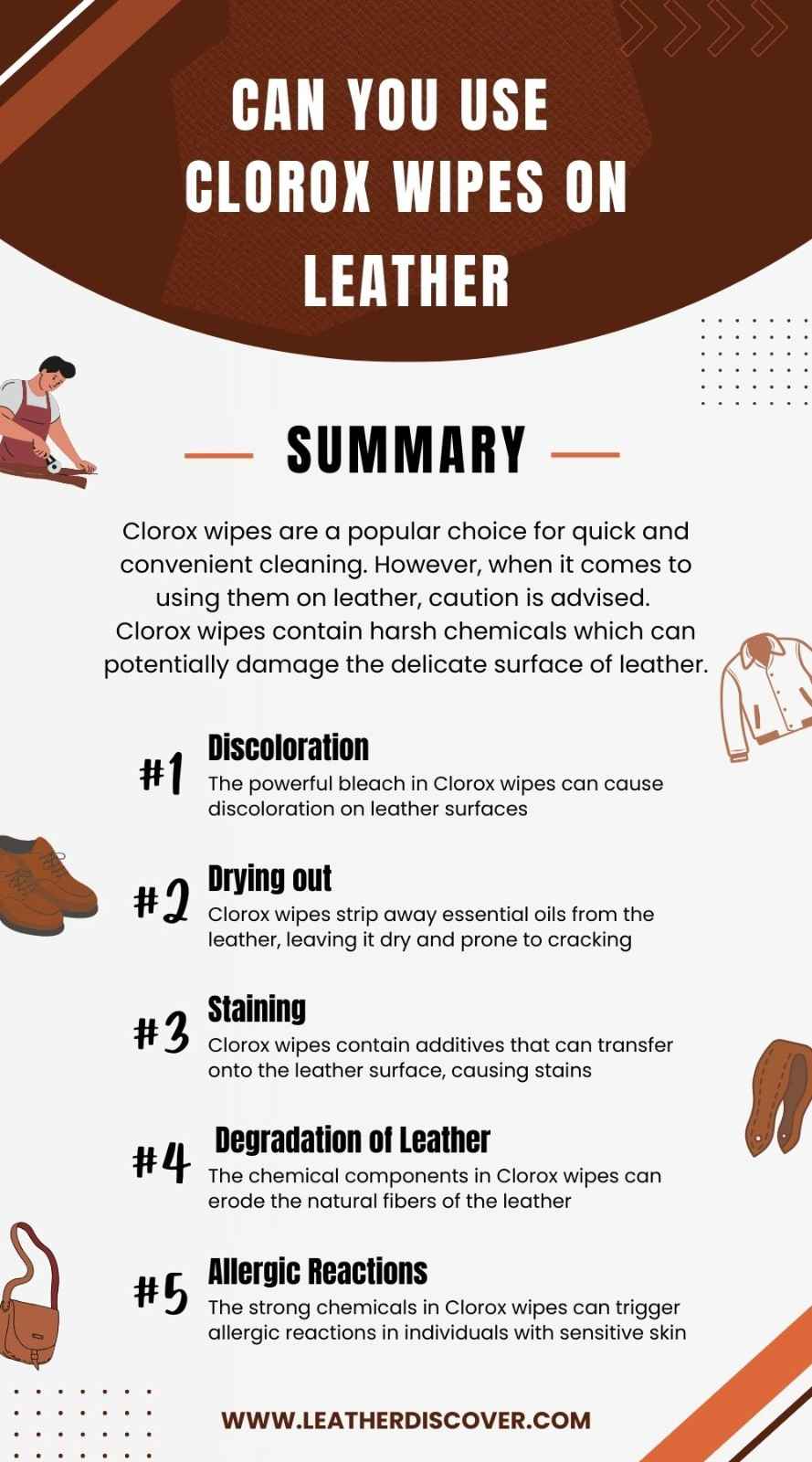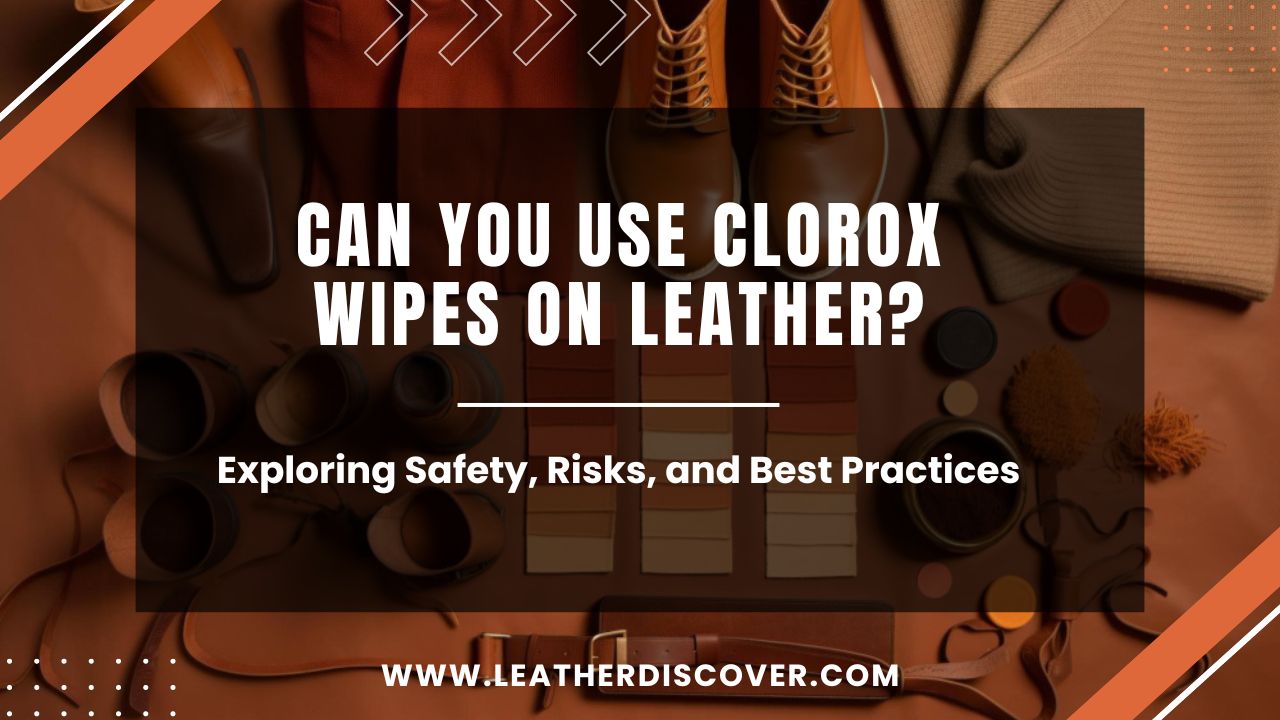Have you ever thought about using Clorox wipes to clean your leather items? Stop right there!
If you want to know Can You Use Clorox Wipes on Leather? The short answer is no, Clorox wipes can damage leather and should be avoided.
Clorox wipes are great for quick cleaning, but when it comes to leather, a word of caution is definitely in order.
These wipes contain powerful chemicals like bleach that are fantastic for disinfecting surfaces but can wreak havoc on leather.
Leather is porous and sensitive; it craves gentle care.
I remember the first time I considered using Clorox wipes on my leather couch. I was looking for a quick cleaning solution but worried about potential damage.
That’s when it hit me: leather and Clorox wipes are not best friends.
In this piece of content, I’m going to discuss why Clorox wipes aren’t suitable for leather and what safer, more effective methods you can use to keep your leather looking its best.
By the end, you’ll know exactly how to care for your leather items without causing harm. Let’s ensure your leather stays beautiful and well-maintained!
[toc]

Examining the Risks of Using Clorox Wipes on Leather
I made the mistake of using Clorox wipes on my beloved leather jacket, and it ended up being a disaster.
Let’s find out why these handy cleaning wipes can be a nightmare for leather items.
1. Discoloration
The powerful bleach and other chemicals in Clorox wipes can cause discoloration on leather surfaces.
The harsh nature of these chemicals can react with the dyes used in the leather, leading to fading or a color change that may be irreversible.
This can result in patches or streaks of lighter or darker shades on the leather, ruining its aesthetic appeal.
2. Drying out
Leather requires proper care and maintenance to retain its natural oils and suppleness.
Clorox wipes contain ingredients that strip away these essential oils from the leather, leaving it dry and prone to cracking.
Dry leather is more susceptible to damage and can lose its luxurious feel and appearance.
3. Staining
Some Clorox wipes contain additives or dyes that can transfer onto the leather surface, causing stains that are difficult to remove.
These stains can be quite noticeable and detract from the overall look of the leather item.
If the wipes are not properly rinsed off after use, residues left behind can attract dirt and grime, further exacerbating the staining issue.
4. Degradation of Leather
The chemical components in Clorox wipes can erode the natural fibers of the leather, leading to the gradual deterioration of the material.
Continuous use of such harsh cleaning agents can weaken the structural integrity of the leather, making it more susceptible to tears, scratches, or permanent damage.
Over time, the leather may lose its durability and lifespan due to this accelerated degradation.
5. Allergic Reactions
The strong chemicals in Clorox wipes can trigger allergic reactions in individuals with sensitive skin or respiratory conditions.
Direct contact with these chemicals during cleaning can cause skin irritation, redness, itching, or even respiratory issues.
People with allergies or skin sensitivities should be particularly cautious while using such wipes on leather surfaces to avoid adverse health effects.
Unlocking the Secrets of Leather Cleaning: Alternatives to Clorox Wipes
So, if Clorox wipes are off the table, what are the alternatives for cleaning leather?
Fortunately, there are several safe and effective methods for cleaning and maintaining leather goods:
1. Mild Soap and Water Solution
Once, after a muddy outdoor adventure, my leather boots were in desperate need of cleaning.
I mixed a little mild dish soap with water, and gently scrubbed away the dirt, and they looked as good as new!
- Dilute a small amount of gentle soap, such as mild dish soap or a specialized leather cleaner.
- Ensure the solution is not too concentrated, as excessive soap can leave residue on the leather surface.
- Dampen a soft, clean cloth with the solution and gently wipe down the leather, focusing on areas with stains or dirt buildup.
- Avoid soaking the leather with excess water, as this can cause damage.
2. Specialized Leather Cleaners
When my leather bag got a stubborn stain from a spilled coffee, this cleaner came to the rescue, lifting the stain without damaging the leather.
- These cleaners are designed to remove dirt, grime, and stains without causing damage or discoloration.
- Look for a pH-balanced leather cleaner free from harsh chemicals, such as bleach or ammonia.
- Follow the manufacturer’s instructions carefully when using leather cleaners, and always test the product in a small, inconspicuous area first.
3. Natural Remedies
I’m a fan of natural cleaning methods. One time, when my leather couch needed a refresh, I reached for a vinegar and water solution.
It did the trick, leaving my couch looking clean and smelling fresh.
- Vinegar, diluted with water in a 1:1 ratio, can be used as a gentle cleaner for leather surfaces.
- Apply the solution to a soft cloth and use it to wipe down the leather, then rinse with a clean, damp cloth and dry thoroughly.
- A mixture of lemon juice and cream of tartar can be used to remove stains from leather.
- Mix equal lemon juice and cream of tartar to form a paste, apply it to the stain, and let it sit for a few hours before wiping it away with a damp cloth.
4. Commercial Leather Wipes
When I’m short on time, I rely on leather cleaning wipes for quick touch-ups.
- These wipes are pre-moistened with gentle cleaning agents that are safe for use on leather surfaces.
- They provide a quick and easy way to clean and condition leather items, making them ideal for regular maintenance.
5. Professional Cleaning Services
When my leather briefcase started showing signs of wear and tear, I took it to a leather cleaning specialist. They worked their magic, and now it looks as good as new!
- Professional leather cleaners have the expertise and specialized equipment to safely and effectively clean leather goods without causing damage.
- They can remove stubborn stains, condition the leather, and restore its luster and suppleness.
How to Clean Leather Safely?
Here’s a simple guide to safely cleaning your leather items:
| Step | Description |
|---|---|
| 1. Assess the Condition | Take a moment to inspect your leather item for stains, dirt, or wear. |
| 2. Choose the Right Cleaner | Use a leather cleaner over harsh alternatives like Clorox wipes. Once, I mistakenly used Clorox wipes on my leather sofa and regretted it when I saw streaks and dried patches. |
| 3. Test in a Small Area | Test in a small area to ensure the cleaner doesn’t damage the leather. |
| 4. Apply the Cleaner | Apply the cleaner with a soft cloth or sponge, using gentle circular motions. I’ve found that using a soft-bristled brush helps lift dirt and grime from textured leather surfaces without causing damage. |
| 5. Rinse and Dry | Rinse away the excess cleaner with a damp cloth and gently dry the leather to prevent damage. I prefer air-drying my leather items to avoid heat damage, especially after cleaning. |
| 6. Condition the Leather | SCleaning can strip away some of the natural oils in leather, so it’s essential to replenish them with a good leather conditioner |
| 7. Maintain Regularly | Cleaning and conditioning your leather items should be part of your regular maintenance routine. I clean, and condition my leather items every few months, ensuring they stay supple and look as good as new. |
Source: Corter Leather YT Channel
Conclusion
While Clorox wipes are an effective cleaning solution for many surfaces, they are not recommended for use on leather.
The harsh chemicals in these wipes can damage the delicate leather surface, leading to dryness, cracking, and discoloration.
Instead, choose gentle cleaning methods such as mild soap and water, leather cleaner, and leather conditioner, to properly care for your leather items.
By following these tips and utilizing safe cleaning practices, you can maintain the beauty and longevity of your leather items for years to come.
Remember, proper care and maintenance are key to preserving the luxurious look and feel of leather.
Resources Consulted
- What Is Caiman Leather? A Detailed Guide - July 25, 2024
- What Is Tumbled Leather?A Complete Guide - July 25, 2024
- What Is Kip Leather? Premium Leather Choice - July 24, 2024

